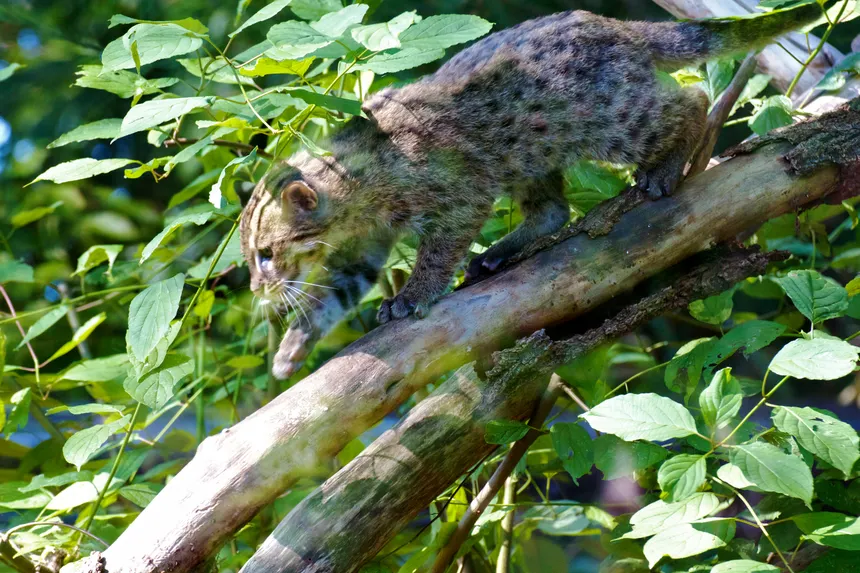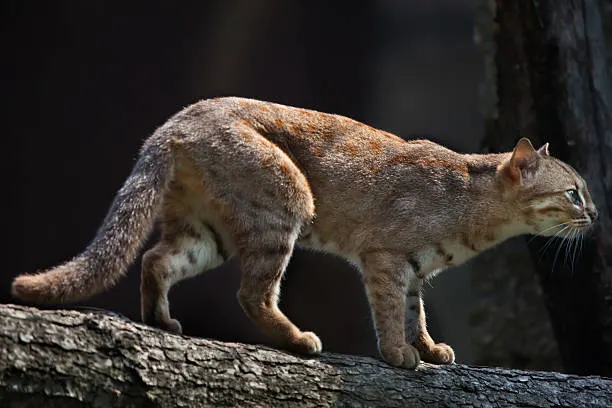“Fishing Cats: The Wetland Hunters You’ve Probably Never Heard Of”

Among the world’s wild felines, the fishing cat (Prionailurus viverrinus) stands out as one of the most unusual and underappreciated species. With webbed feet, a love of water, and exceptional hunting skills, this nocturnal predator has evolved to thrive in wetlands—a habitat most cats avoid. Found primarily in South and Southeast Asia, fishing cats are both elusive and endangered, making them a subject of growing interest and conservation concern.
1. Webbed Feet and Swimming Prowess
Unlike most members of the cat family, fishing cats are excellent swimmers. They possess partially webbed front feet, which help them move effortlessly through water. These adaptations make them powerful, agile hunters in aquatic environments like marshes, swamps, and mangroves.
2. Masters of Aquatic Hunting
As their name suggests, fishing cats are experts at catching fish. Their hunting techniques include:
- Tapping the water’s surface to imitate insect movements and attract fish.
- Diving and swimming after prey, including fish, frogs, crustaceans, and even water snakes.
- Using stealth and stillness to ambush prey near the water’s edge.
They have been observed to dive underwater and catch fish with their claws, a behavior that is extremely rare among felines.
3. A Cat with a Taste for Wetlands
Fishing cats prefer wetland habitats, including:
- Mangrove forests (like the Sundarbans of India and Bangladesh)
- Freshwater marshes and swamps
- Riverbanks, reed beds, and estuaries
These ecosystems are rich in prey but increasingly endangered due to human development and agriculture, threatening the fishing cat’s survival.

4. Unusual Appearance
Fishing cats are stocky and muscular, with:
- A short, dense coat that’s water-resistant
- A greyish olive coat with black spots and stripes for camouflage
- A flattened head and broad muzzle that assist in underwater vision
- A short tail, useful for balance when stalking prey along slippery banks
They typically weigh between 6 to 16 kg (13–35 pounds) and measure about two to three feet in length.
5. Shy and Solitary Nature
Fishing cats are solitary and nocturnal, making them hard to observe in the wild. They communicate with low growls, hisses, and chuckles, and are rarely seen during the day. Males and females generally only come together to mate, and mothers raise their kittens alone in dense vegetation or burrows.
6. Conservation Status: Endangered and Overlooked
According to the IUCN Red List, the fishing cat is classified as Vulnerable due to:
- Wetland destruction from farming, aquaculture, and urban sprawl
- Poaching and retaliation killings by farmers who view them as threats to poultry
- Lack of awareness, even among local communities
Conservation efforts now focus on habitat protection, wetland restoration, and public education to prevent further decline.
7. Cultural Significance
In parts of India and Sri Lanka, fishing cats are sometimes mistaken for leopards and feared. However, they are increasingly becoming symbols of wetland conservation. Local myths in West Bengal even describe them as “fish thieves” who were once human, linking them to folklore and traditional beliefs.
Conclusion: A Rare Gem of the Wetlands
The fishing cat is an extraordinary example of nature’s adaptability. With its amphibious lifestyle, webbed paws, and aquatic hunting skills, it defies what we typically expect from a feline. As wetlands vanish and the species faces greater threats, protecting this remarkable cat has become more urgent than ever.
Learning about the fishing cat isn’t just fascinating—it’s also a step toward preserving the rich biodiversity of our planet’s disappearing wetlands.



